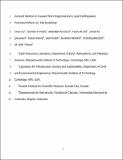Ground Motion in Kuwait from Regional and Local Earthquakes: Potential Effects on Tall Buildings
Author(s)
Gu, Chen; Prieto, Germán A; Al-Enezi, Abdullah; Al-Jeri, Farah; Al-Qazweeni, Jamal; Kamal, Hasan; Kuleli, Sadi; Mordret, Aurélien; Büyüköztürk, Oral; Toksöz, M. N; ... Show more Show less
Download24_2018_1943_ReferencePDF.pdf (2.663Mb)
Open Access Policy
Open Access Policy
Creative Commons Attribution-Noncommercial-Share Alike
Terms of use
Metadata
Show full item recordAbstract
Abstract
In recent years, the construction of tall buildings has been increasing in many countries, including Kuwait and other Gulf states. These tall buildings are especially sensitive to ground shaking due to long period seismic surface waves. Although Kuwait is relatively aseismic, it has been affected by large (Mw > 6) regional earthquakes in the Zagros Fold-Thrust Belt (ZFTB). Accurate ground motion prediction for large earthquakes is important to assess the seismic hazard to tall buildings. In this study, we first analyze the observed ground motions due to two earthquakes widely felt in Kuwait: the 08/18/2014 Mw 6.2 earthquake, 360 km NNE of Kuwait City, and the 11/12/2017 Mw 7.3 earthquake, 642 km NNE of Kuwait City. The peak spectral displacement periods of the ground motion from the 08/18/2014 Mw 6.2 earthquake matched well with the ambient vibration spectra of the tallest building—the Al-Hamra Tower. We calculate the ground motions from potential regional and local earthquakes. We use a velocity model obtained by matching the observed seismograms of the 2014 and 2017 earthquakes. We calculate ground motions in Kuwait due to a regional Mw = 7.5 earthquake, and a local Mw = 5.0 earthquakes. Our study shows that a significant source of seismic hazard to tall buildings in Kuwait comes from the regional tectonic earthquakes. However, local earthquakes have the potential to generate high peak ground accelerations (~ 98 cm/s2) close to their epicenters.
Date issued
2018-07-10Department
Massachusetts Institute of Technology. Earth Resources Laboratory; Massachusetts Institute of Technology. Department of Earth, Atmospheric, and Planetary Sciences; Massachusetts Institute of Technology. Department of Civil and Environmental Engineering. Laboratory for Infrastructure Science and Sustainability; Massachusetts Institute of Technology. Department of Civil and Environmental EngineeringPublisher
Springer International Publishing